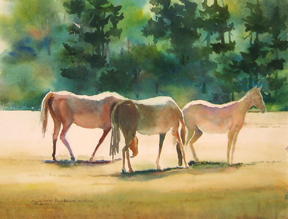 Now that we are headed toward plein air painting, you might find it useful to review the GREEN entry in July and DARKS in August of 08 — which leads us right in to a question that has come up several times this month, “Which colors should I buy?”
Now that we are headed toward plein air painting, you might find it useful to review the GREEN entry in July and DARKS in August of 08 — which leads us right in to a question that has come up several times this month, “Which colors should I buy?”
It seems every instructor has a different list and every month new colors come on the market. Do you need them all? Do you want so many? What ones must you have?
Right off here are Some Guidelines:
- You CAN paint in only three colors: red yellow and blue
- Work out a combination that fits in your palette’s holes (mine has 20)
- Arrange them in a color wheel
- Always buy Artist quality –but there are lots of fine brands
- Avoid colors that say “hue” such as “Cobalt Blue hue.” When you read the fine print, they are mixes of lesser pigments. Part of cobalt blue’s quality IS the cobalt. You too can mix the hue out of lesser pigments. You don’t need to fill a hole with those.
- Read the fine print — avoid pigments that are a mix such as Pyrrol red and Ultramarine blue. Buy the single hue pigments.
Paint with the prism.
You probably know this, but we see because of light — because of the sun. Think of a dark room that is slowly coming into light — black to grays, to color. The colors we see are made by the color waves from the sun. If you take a crystal or a prism and fracture the light you get green, yellow, orange, red, violet, and blue– the colors of the rainbow. These are known as prismatic hues or pure color. They make up every color you see. Every color you want to paint.
For three years I painted with only cadmium yellow light, alizeran crimson, and pthalo blue. Alizeran isn’t quite a dead-on red so I now use quinacradone red or perylene red. I still use the other two as my major primaries.
If you want all six, I would choose a clear orange such as perinone orange, pthalo green and one of any number of clear violets — quinacridone violet (a little red), Winsor violet (toward the blue) or another. With these six practice making and matching colors before you add any others. Learn to match the colors you see.
I once had a student arrive at a plein air location and say, “I can’t paint the sky today. I left my cerulean blue home.” What is cerulean blue — as far as hue (not its sedimentary quality)? a light, slightly green blue, right? So try a litttle phatho blue with more water than pigment. Too dark? Thin it out with more water. Not quite green enough? Add a tiny amount of green or of yellow. If it goes too green, try it again. Less green or yellow.
Can you paint the color of oak wood? Of maple? Of walnut? Mahogony? Cherry wood?
- choose the main hue (red, yellow, green?)
- decide how light or dark — more pigment or more water
- start with that and then mix into it what else is need
Let’s try maple. It is a brown that is on the yellow side, right? Start with a little patch of yellow and add some red (not as much as the yellow). Too bright? Use just the tiniest amount of blue unti you get it. do it again if you miss the first time.
How about mahogony? A deep red brown. So — start with red. Add not quite as much yellow and then some blue. Is it dark enough? Is it red enough? Too yellow? Add more red and maybe blue. Too orange? Add more blue. Keep trying until it comes easily.
What other “off” colors do you own? Raw sienna? Sepia?Indigo? Cascade Green? Some kind of magenta? See if you can match them, mixing your red yellow and blue.
For example, indigo is just a blackened blue. Start with the pthalo blue and add a little of your violet and a little of your green. There you are!
Why green and violet? All three primaries together make gray. These strong ones (red in the violet, yellow in the green, and blue) will get you a blackened blue faster than using red and yellow, but you can try it that way too.
Try the green and the darks lessons mentioned above.See how much variety of a hue (like green) you can make just using the three primaries. Then just using the six prismatic hues. Keep it green — but make it an orange green, a blue green, a violet green, a black green, a yellow green.
I’ll get some more examples up but tomorrow I am going over to Orcas to set up for the Color week. Sorry if you are not going to be there. It’s going to be a good week. But you can still work on mixing your colors.
Caroline
©2009
